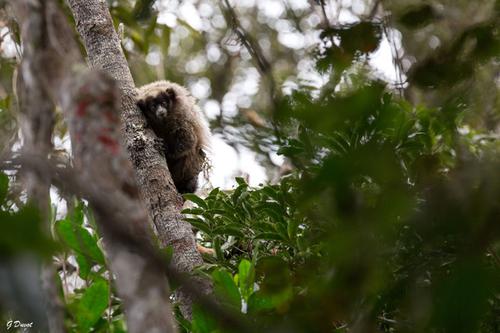当前位置:
X-MOL 学术
›
Am. J. Primatol.
›
论文详情
Our official English website, www.x-mol.net, welcomes your feedback! (Note: you will need to create a separate account there.)
Dramatic decline in a titi monkey population after the 2016–2018 sylvatic yellow fever outbreak in Brazil
American Journal of Primatology ( IF 2.4 ) Pub Date : 2021-10-05 , DOI: 10.1002/ajp.23335 Mélissa Berthet 1 , Geoffrey Mesbahi 2, 3 , Guilhem Duvot 1 , Klaus Zuberbühler 4, 5 , Cristiane Cäsar 6 , Júlio Cèsar Bicca-Marques 7
American Journal of Primatology ( IF 2.4 ) Pub Date : 2021-10-05 , DOI: 10.1002/ajp.23335 Mélissa Berthet 1 , Geoffrey Mesbahi 2, 3 , Guilhem Duvot 1 , Klaus Zuberbühler 4, 5 , Cristiane Cäsar 6 , Júlio Cèsar Bicca-Marques 7
Affiliation

|
Platyrrhini are highly vulnerable to the yellow fever (YF) virus. From 2016 to 2018, the Atlantic Forest of southeast Brazil faced its worst sylvatic YF outbreak in about a century, thought to have killed thousands of primates. It is essential to assess the impact of this epidemic on threatened primate assemblages to design effective conservation strategies. In this study, we assessed the impact of the 2016–2018 YF outbreak on a geographically isolated population of Near Threatened black-fronted titi monkeys (Callicebus nigrifrons) in two Atlantic Forest patches of the Santuário do Caraça, MG, Brazil. Extensive preoutbreak monitoring, conducted between 2008 and 2016, revealed that the home range and group sizes of the population remained stable. In 2016, the population size was estimated at 53–57 individuals in 11–12 groups. We conducted monitoring and playback surveys in 2019 and found that the population had decreased by 68% in one forest patch and completely vanished in the other, resulting in a combined decline of 80%. We discuss this severe loss of a previously stable population and conclude that it was highly likely caused by the YF outbreak. The remaining population is at risk of disappearing completely because of its small size and geographic isolation. A systematic population surveys of C. nigrifrons, along other sensible Platyrrhini species, is needed to re-evaluate their current conservation status.
中文翻译:

2016-2018 年巴西森林黄热病爆发后,提提猴种群数量急剧下降
Platyrrhini 极易感染黄热病 (YF) 病毒。从 2016 年到 2018 年,巴西东南部的大西洋森林面临着大约一个世纪以来最严重的森林黄热病爆发,据认为已经杀死了数千只灵长类动物。评估这种流行病对受威胁的灵长类动物群落的影响以设计有效的保护策略至关重要。在这项研究中,我们评估了 2016-2018 年 YF 爆发对地理上孤立的近危黑额提提猴 ( Callicebus nigrifrons ) 种群的影响。) 位于巴西 MG 的 Santuário do Caraça 的两个大西洋森林斑块中。2008 年至 2016 年间进行的广泛的疫情爆发前监测显示,人口的家庭范围和群体规模保持稳定。2016 年,人口规模估计为 11-12 组中的 53-57 人。我们在 2019 年进行了监测和回放调查,发现一个森林斑块的人口减少了 68%,而在另一个森林斑块中则完全消失了,总共下降了 80%。我们讨论了先前稳定人口的严重损失,并得出结论,这很可能是由 YF 爆发引起的。剩余的人口由于规模小和地理隔离而面临完全消失的风险。C. nigrifrons的系统种群调查,以及其他明智的 Platyrrhini 物种,需要重新评估其当前的保护状况。
更新日期:2021-11-29
中文翻译:

2016-2018 年巴西森林黄热病爆发后,提提猴种群数量急剧下降
Platyrrhini 极易感染黄热病 (YF) 病毒。从 2016 年到 2018 年,巴西东南部的大西洋森林面临着大约一个世纪以来最严重的森林黄热病爆发,据认为已经杀死了数千只灵长类动物。评估这种流行病对受威胁的灵长类动物群落的影响以设计有效的保护策略至关重要。在这项研究中,我们评估了 2016-2018 年 YF 爆发对地理上孤立的近危黑额提提猴 ( Callicebus nigrifrons ) 种群的影响。) 位于巴西 MG 的 Santuário do Caraça 的两个大西洋森林斑块中。2008 年至 2016 年间进行的广泛的疫情爆发前监测显示,人口的家庭范围和群体规模保持稳定。2016 年,人口规模估计为 11-12 组中的 53-57 人。我们在 2019 年进行了监测和回放调查,发现一个森林斑块的人口减少了 68%,而在另一个森林斑块中则完全消失了,总共下降了 80%。我们讨论了先前稳定人口的严重损失,并得出结论,这很可能是由 YF 爆发引起的。剩余的人口由于规模小和地理隔离而面临完全消失的风险。C. nigrifrons的系统种群调查,以及其他明智的 Platyrrhini 物种,需要重新评估其当前的保护状况。



























 京公网安备 11010802027423号
京公网安备 11010802027423号